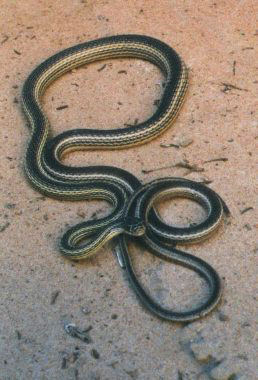Striped Whip Snakes can be found
throughout the west, and are generally found in grasslands and dry
brushy flatland to rugged mountainous terrain dominated by pinyon-juniper
and open  pine-oak
woodlands at elevations from sea level to 9,400 feet. The snakes prefer
moist areas near streams, where they forage. They often use rocky
outcrops, rodent burrows, vegetation for shelter. pine-oak
woodlands at elevations from sea level to 9,400 feet. The snakes prefer
moist areas near streams, where they forage. They often use rocky
outcrops, rodent burrows, vegetation for shelter.
|
The name "whipsnake" comes from
the fact that the snake somewhat resembles a leather whip. |
Whipsnakes prey on lizards, snakes, frogs, insects,
small birds and rodents. Occasionally, a small venomous snake may be
eaten. During the day, it hunts with head held high, scanning for
possible prey. The snakes typically breed in early spring using
abandoned rodent burrows as nesting sites. Females laying between 3-12
eggs in June or July. The young hatch in late summer and are about 15
inches long. Males mature faster than females and reach breeding age in
two years, and the females, at three years of age. |

